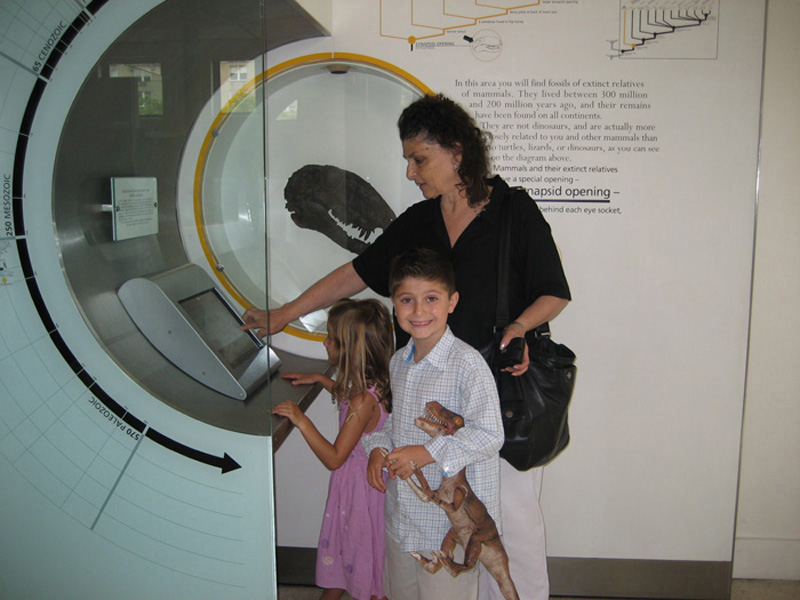Ellie with granddaughter Joie, and Grandson, Giovanni

Humans seem to have a fascination with dinosaurs highlighted at age 7.
Ellie with granddaughter Joie, and Grandson, Giovanni

Humans seem to have a fascination with dinosaurs highlighted at age 7.
Tuesday June 9, 2015
There may be physical evidence of the Jurassic timeline, but as our experiences are holographic inserts, try to view reality from that perspective - especially as merge is occurring. As of 2014 the RHIC (Rick) and the LHC - the only operating hadron colliders in the world - both breaking boundaries so please pay attention. One of them will breach reality when the algorithm of our experience ends at Zer0.
In sci-fi films, people sometimes time travel back to that timeline but it's all just a story - a film strip set in time for you to experience vicariously triggering fear. We seem to be programmed for fear as a wake-up mechanism.
Do you remember seeing any of the Jurassic Park films? I saw the first of the series - screenplay by Michael Crichton - directed by Steven Spielberg. On June 11, 2015 the next in the series opened in US theaters - Jurassic World.
A Paleontologist Deconstructs 'Jurassic World'
NY Times - June 12, 2015
In the news ...
We do love sci-fi adventures especially at this time of the year. Jurassic World Tromps All Over the Box Office Competition New York Times - June 15, 2015
Jurassic World powered through squishy reviews to post a near-record $204.6 million in estimated weekend sales at the domestic box office, and about $512 million worldwide.
The town where dinosaurs and Jesus mingle BBC - June 14, 2015
Jesus and the dinosaurs are living happily alongside one another in a town in Canada - but can the peace last, asks Tom Holland. Drumheller is definitely the place to visit if you like dinosaurs. Perched amid the fossil-rich badlands above the town, the Royal Tyrrell Museum is probably the greatest treasure trove of palaeontological riches anywhere in the world, boasting everything from three complete tyrannosaur skeletons to a single delicate dinosaur feather preserved in amber.
How Dinosaurs Shrank and Became Birds Scientific American - June 13, 2015
Modern birds descended from a group of two-legged dinosaurs known as theropods, whose members include the towering Tyrannosaurus rex and the smaller velociraptors. The theropods most closely related to avians generally weighed between 100 and 500 pounds - giants compared to most modern birds - and they had large snouts, big teeth, and not much between the ears. A velociraptor, for example, had a skull like a coyoteÕs and a brain roughly the size of a pigeon's.
Researchers hot on the trail of Velociraptor relative Science Daily - June 11, 2015
In a discovery seemingly straight from the movie 'Jurassic World,' researchers have just documented a rich fossil footprint site in central China containing tracks by several kinds of dinosaurs, including raptors. From these tracks, the team has gained new insights into how raptors moved.
Preserved dinosaur cells found, but scientists still can't build Jurassic World PhysOrg - June 10, 2015
The science behind the Jurassic Park films always seemed far-fetched, even before the latest installment, Jurassic World, introduced the idea of genetically engineered super-dinosaurs. For one thing, finding mosquitoes that had drunk the blood of dinosaurs and then been preserved in amber for hundreds of millions of years is incredibly unlikely. But there's another more important reason: organic molecules such as proteins and DNA degrade fast after a creature's death. They are almost never found preserved in bones older than a few thousand years. This has been the dogma for many years.
Wales' 'first meat-eating' Jurassic dinosaur on show BBC - June 9, 2015
A fossilized skeleton of a meat-eating Jurassic dinosaur found on a south Wales beach is being revealed to the public for the first time. The small theropod dinosaur - a distant cousin of the giant Tyrannosaurus rex - was uncovered by spring storms in 2014 at Lavernock, Vale of Glamorgan.
'Blood cells' found in dino fossils BBC - June 9, 2015
Researchers have discovered what appear to be the remnants of red blood cells and connective tissue in 75 million-year-old dinosaur fossils. The work could shine a light on long-standing questions about dinosaur physiology, including whether specific species were warm- or cold-blooded. Chemical analysis revealed similarities between blood cells from fossils and those from living emu.
About ...
Jurassic is a geologic period and system that extends from 201.3± 0.6 Ma (million years ago) - from the end of the Triassic to the beginning of the Cretaceous. The Jurassic constitutes the middle period of the Mesozoic Era, also known as the Age of Reptiles. The start of the period is marked by the major Triassic-Jurassic extinction event. Two other extinction events occurred during the period: the Late Pliensbachian/Early Toarcian event in the Early Jurassic, and the Late Tithonian event at the end; however, neither event ranks among the "Big Five" mass extinctions.
The Jurassic is named after the Jura Mountains within the European Alps, where limestone strata from the period were first identified. By the beginning of the Jurassic, the supercontinent Pangaea had begun rifting into two landmasses, Laurasia to the north and Gondwana to the south. This created more coastlines and shifted the continental climate from dry to humid, and many of the arid deserts of the Triassic were replaced by lush rainforests.
On land, the fauna transitioned from the Triassic fauna, dominated by both dinosauromorph and crocodylomorph archosaurs, to one dominated by dinosaurs alone. The first birds also appeared during the Jurassic, having evolved from a branch of theropod dinosaurs. Other major events include the appearance of the earliest lizards, and the evolution of therian mammals, including primitive placentals. Crocodylians made the transition from a terrestrial to an aquatic mode of life. The oceans were inhabited by marine reptiles such as ichthyosaurs and plesiosaurs, while pterosaurs were the dominant flying vertebrates. Read more